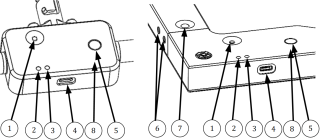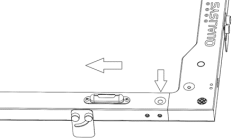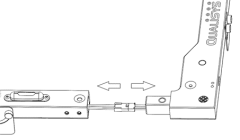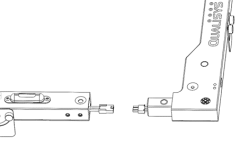Qualisys calibration kits
Qualisys offers a range of wand calibration kits for a variety of applications.
-
Standard calibration kits
The carbon fiber 300 mm and 600 mm calibration kits are recommended for standard capture volumes with camera distances ranging from about 3 to 35 m. For larger capture volumes or volumes that contain force plates, the carbon fiber 600 mm is recommended. For smaller capture volumes the carbon 300 mm kit is recommended. -
Small calibration kit
The 120 mm calibration kit is intended for small volumes with camera distances ranging from about 1 to 3 m. The 120 mm kit is especially recommended for small capture volume applications that require high accuracy. -
Active calibration kits
Two types of active calibration kits are available. The active calibration kits are especially recommended for outdoor capture volumes. The long range active marker (LRAM) calibration kit (1000 mm) is recommended for large capture volumes with camera distances of 10 m or larger. The active 500 mm calibration kit is recommended for standard capture volumes with camera distances of 5 to 35 m, and can be used for both marker and video cameras.
The following chapters contain practical information for selected calibration kits. For more detailed technical information, contact support@qualisys.com.
Carbon fiber 600 mm wand kit
The carbon fiber wand kit consists of a carbon fiber wands with a length of 600 mm and a L-frame where the long arm is about 600 mm long.
The wand is attached to the handle by pressing and turning it in the track until the handle locks. Make sure that you lock the handle so that the wand is not dropped and the markers damaged.
The L-frame rests on three points. A static corner point that is the origin when calibrating in QTM. The resting points on the arms are adjustable with the adjustment wheels. Check the spirit levels on the frame and adjust the points so that the L-frame is level.
There are also force plate positioning plates on the side of the L-frame, so that the L-frame can be placed on the same position on the force plate for every calibration. Loosen the screws to fold down the positioning plates, then tighten the screws before placing the L-frame on the force plate with the positioning plates on the sides of the force plate.
When folded the L-frame is held together by a magnet. To open the L-frame pull the arms and unfold the arms to the maximum position. The arms are then locked, so to fold it pull the red locking sprint away from the center.
The origin of the L-frame is automatically translated to the corner point (X=-10, Y=-10, Z=-49, relative to the corner marker).
Active 500 mm wand kit
Indicators and buttons
-
Power button
Press button to start device.
Keep button pressed for about one second until both indicators turns off. -
Battery indicator
Green light - Battery status ok
Red/yellow light - Charge battery -
Status indicator
Green light - Idle
Yellow light - Triggered
Red light - Battery charging -
USB-C connector
Used to charge battery and configure device -
IR detector
Used for synchronizing the LEDs to Camera system -
Set screws
Use the included T-handle to lock the two parts together rigidly -
Release button
See disassembly instruction below. -
Reset
Access to reset button.
Assembly and disassembly
It is recommended to store the L-frame in one piece. In case the L-frame needs to be disassembled, for example for transport, follow these instructions.
-
Press the release button and pull gently on the short arm of the L-structure to separate it into two pieces. Make sure the locking setscrews are disengaged.
-
Disconnect the connector.
-
The two pieces are now separated. Assembly is done in the reverse order.
How to use the active 500 mm calibration kit
The active 500 mm calibration kit has compound white and IR LEDs, and can be used for the calibration of both marker and video cameras. To use the active calibration kit, the cameras need to be in active marker mode, see chapter Marker mode. The recommended exposure time of the cameras is 400-500 μs.
For outdoor use, it is recommended to use active filtering, see chapter Active filtering.
The markers on the L-frame and the wand are only visible on one side, unlike spherical markers. When moving the wand, it is important to be aware that the view angle of the markers is limited to max 90 degrees relative to the view direction of the cameras. Make sure that there are always cameras that can see the markers while moving the wand. For example, if all cameras are mounted in high positions, the marker side of the wand should never be pointed towards the floor.
The L-frame can be leveled using the level adjustment screws at the end of both arms while monitoring the spirit levels.
The L-frame also contains positioning plates for reproducible placement of the L-frame on a force plate.
When using a system with only Miqus video cameras for markerless motion capture, the cameras should be equipped with strobes that contain one IR LED. Contact support@qualisys.com if you need to upgrade the strobes of your Miqus video cameras.
Configuration
The active 500 mm L-frame and wand can be configured via the USB-C port. The options that can be configured are: triggering mode (triggered, untriggered), LED activation (IR, white or both), and intensity (default power and high power). The active 500 mm calibration kit is by default configured in triggered mode, with both IR and white LEDs activated and a flash time of 400 μs.
The untriggered mode can be used if the L-frame needs to be visible for non-Qualisys cameras, e.g. standard video cameras.
For more information about how to configure the active calibration kit, contact support@qualisys.com.
The battery time is significantly reduced when using untriggered mode.
Battery and charging
The L-frame and wand can be charged using any standard USB-C charger. The charging time is less than 2 hours. The battery time for the default configuration (triggered, white and IR LEDs) is 10 hours or more for the L-frame and 20 hours or more for the wand.



